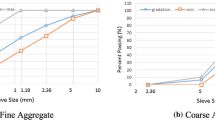Abstract
The compressive strength of heavyweight concrete which is produced using baryte aggregates has been predicted by artificial neural network (ANN) and fuzzy logic (FL) models. For these models 45 experimental results were used and trained. Cement rate, water rate, periods (7–28–90 days) and baryte (BaSO4) rate (%) were used as inputs and compressive strength (MPa) was used as output while developing both ANN and FL models. In the models, training and testing results have shown that ANN and FL systems have strong potential for predicting compressive strength of concretes containing baryte (BaSO4).










Similar content being viewed by others
Explore related subjects
Discover the latest articles and news from researchers in related subjects, suggested using machine learning.References
Turkish code 11222 (1980) Concrete, ready concrete. TSE, Ankara (in Turkish)
Kilincarslan S, Akkurt I, Basyigit C (2006) The effect of baryte rate on some physical and mechanical properties of concrete. Mater Sci Eng A 424:83–86
Varshney RS (1982) Concrete technology, 2nd edn. Oxford & IBH Publishing Co., New Delhi
Topçu IB (2003) Properties of heavyweight concrete produced with baryte. Cement Concrete Res 33–36:815
Topçu IB, Sengel S (2004) Properties of concretes produced with waste concrete aggregate. Cement Concrete Res 34–38:1307
Topçu IB, Canbaz M (2004) Properties of concretes containing waste glass. Cement Concrete Res 34–42:267
Bilim C et al (2009) Predicting the compressive strength of ground granulated blast furnace slag concrete using artificial neural network. Adv Eng Softw 40:334–340
Demir F (2008) Prediction of elastic modulus of normal and high strength concrete by artificial neural networks. Construction Build Mater 22:1428–1435
Topçu IB, Sarıdemir M (2008) Prediction of compressive strength of concrete containing fly ash using artificial neural networks and fuzzy logic. Comput Mater Sci 41:305–311
Sarıdemir M et al (2009) Prediction of long-term effects of GGBFS on compressive strength of concrete by artificial neural networks and fuzzy logic. Construction Build Mater 23:1279–1286
Lee S-C (2003) Prediction of concrete strength using artificial neural networks. Eng Struct 25:849–857
Parichatprecha R, Nimityongskul P (2009) Analysis of durability of high performance concrete using artificial neural networks. Construction Build Mater 23:910–917
Özcan F et al (2009) Comparison of artificial neural network and fuzzy logic models for prediction of long-term compressive strength of silica fume concrete. Adv Eng Softw 40(9):856–863
Topçu IB, Sarıdemir M (2008) Prediction of rubberized concrete properties using artificial neural network and fuzzy logic. Construction Build Mater 22:532–540
Tanyildizi H (2009) Fuzzy logic model for prediction of mechanical properties of lightweight concrete exposed to high temperature. Mater Des 30:2205–2210
Cevik A, Guzelbey IH (2008) Neural network modeling of strength enhancement for CFRP confined concrete cylinders. Build Environ 43:751–763
Topçu IB, Sarıdemir M (2008) Prediction of compressive strength of concrete containing fly ash using artificial neural network and fuzzy logic. Comput Mater Sci 41(3):305–311
TS EN 802 (1985) Design of concrete mixture. TSE, Ankara (in Turkish)
Hou T-H, Su C-H, Chang H-Z (2008) Using neural networks and immune algorithms to find the optimal parameters for an IC wire bonding process. Expert Syst Appl 34:427–436
Zadeh LA (1965) Fuzzy Sets. Inf Control 8:338–352
Topçu IB, Sarıdemir M (2008) Prediction of Rubberized concrete properties using artificial neural networks and fuzzy logic. Construction Build Mater 22(4):532–540
Beycioğlu A (2008) Modellıng the effects of industrıal wastes on propertıes of lıghtweıght concrete by fuzzy logıc method. M.Sc. thesis, Construction Education Department, Graduate School of Applied and Natural Science, Süleyman Demirel University
Terzi S (2007) Modeling the pavement service ability ratio of flexible highway pavements by artificial neural networks. Construction Build Mater 21:590–593
Author information
Authors and Affiliations
Corresponding author
Rights and permissions
About this article
Cite this article
Başyigit, C., Akkurt, I., Kilincarslan, S. et al. Prediction of compressive strength of heavyweight concrete by ANN and FL models. Neural Comput & Applic 19, 507–513 (2010). https://doi.org/10.1007/s00521-009-0292-9
Received:
Accepted:
Published:
Issue Date:
DOI: https://doi.org/10.1007/s00521-009-0292-9




